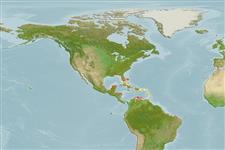Common names from other countries
Malacostraca |
Decapoda |
Laomediidae
Environment: milieu / climate zone / depth range / distribution range
Ecology
Benthic; brackish; depth range 0 - 1 m (Ref. 97531). Tropical
Western Atlantic: USA to Brazil.
Length at first maturity / Size / Weight / Age
Maturity: Lm ? range ? - ? cm
Carapace has well-defined linea thalassinica and cervical groove; rostrum is short and anteriorly rounded, weakly to moderately developed, reaching well beyond the eyes' cornea; body poorly calcified and thin-walled abdomen.
It burrows in coastal mangroves and adjacent mud flats; adapted to strongly hypoxic and reduced (sulfidic) environments (Ref. 96414). Intertidal (Ref. 97531).
Life cycle and mating behavior
Maturity | Reproduction | Spawning | Eggs | Fecundity | Larvae
Members of the order Decapoda are mostly gonochoric. Mating behavior: Precopulatory courtship ritual is common (through olfactory and tactile cues); usually indirect sperm transfer.
MarineSpecies.org. 2050. (Ref. 3477)
IUCN Red List Status
(Ref. 130435: Version 2025-1)
CITES status (Ref. 108899)
Not Evaluated
Not Evaluated
Threat to humans
Harmless
Human uses
| FishSource |
Tools
More information
Trophic EcologyFood items (preys)
Diet composition
Food consumption
Predators
Population dynamicsGrowth
Max. ages / sizes
Length-weight rel.
Length-length rel.
Length-frequencies
Mass conversion
Abundance
Life cycleReproductionMaturityFecunditySpawningEggsEgg developmentLarvae PhysiologyOxygen consumption
Human RelatedStamps, coins, misc.
Internet sources
Estimates based on models
